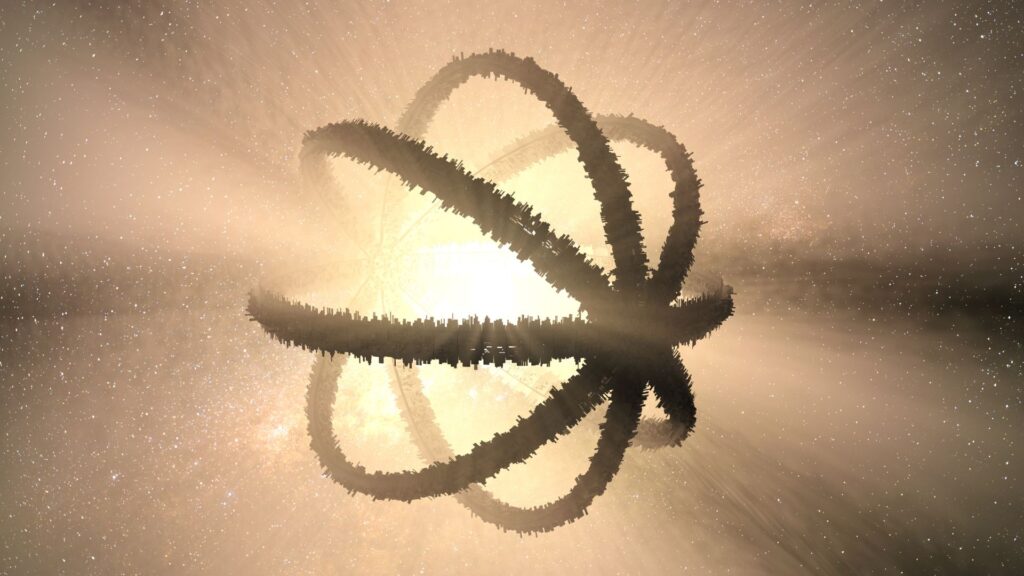Introduction
In the vast expanse of the universe, the possibility of extraterrestrial life has captivated the human imagination for centuries. Yet, despite our best efforts, we have yet to make contact with intelligent beings from distant worlds.
This intriguing conundrum, known as the Fermi Paradox, has sparked numerous theories and speculations. One compelling and thought-provoking concept that seeks to explain the silence of the cosmos is the Zoo Hypothesis.
This hypothesis, proposed by astrophysicist Dr. Kevin Knuth, posits that advanced civilizations might be observing us from afar but choose not to reveal themselves. Let’s embark on an analytical journey to explore this fascinating notion and the mysteries it unravels.

What is the Zoo Hypothesis?
The Zoo Hypothesis proposes that advanced extraterrestrial civilizations are aware of humanity’s existence but intentionally refrain from making direct contact. Just like visitors to a zoo observe animals without disrupting their natural behavior, these alien societies may be watching us from a distance, allowing us to evolve and develop on our own terms.
The Fermi Paradox: Silence in the Cosmos
The Fermi Paradox revolves around a simple yet profound question: if the universe is teeming with potentially habitable planets and intelligent life, why haven’t we encountered any extraterrestrial civilizations? The immensity of the cosmos and its age seems to make the existence of advanced civilizations highly likely. However, the absence of any conclusive evidence raises intriguing questions.
The Great Silence and the Search for Extraterrestrial Intelligence (SETI)

The concept of the Great Silence embodies the puzzling lack of communication from extraterrestrial beings. Despite our efforts to reach out through the Search for Extraterrestrial Intelligence (SETI), the skies remain eerily quiet. Scientists have employed various techniques, such as radio telescopes, to detect signs of technological activity from distant stars, but the results have been inconclusive.
The Zoo Hypothesis: A Plausible Solution
Dr. Kevin Knuth’s 2009 paper titled “The Zoo Hypothesis: A Solution to the Fermi Paradox?” offers an intriguing perspective on this cosmic conundrum. He argues that the zoo hypothesis provides a plausible explanation for the lack of contact with advanced civilizations. According to Knuth, the universe’s vastness and age make it highly likely that other intelligent beings exist.
Reasons for Avoiding Contact
The zoo hypothesis suggests several reasons why advanced civilizations might choose to avoid contact with humanity. One such reason is the fear of potential threats. Considering our history of conflicts and aggression, they may view us as a potentially dangerous species. Alternatively, they might believe that we are not yet mature enough to handle interactions with advanced beings.

Guardians of Natural Development
Another facet of the zoo hypothesis proposes that advanced civilizations may act as benevolent observers, ensuring that we are left to develop naturally. Just as environmentalists advocate for minimal interference with natural habitats, these beings might be avoiding contact to preserve our natural development.
Contact Hypothesis: Are We Ready?
The Contact Hypothesis delves into the potential outcomes of direct communication with extraterrestrial civilizations. Some experts argue that such contact could lead to beneficial exchanges of knowledge and technology, fostering mutual growth. On the contrary, others caution against the potential hazards of encountering a vastly superior civilization that might exploit or dominate us.

Exploring the Galactic Zoo Hypothesis
Expanding on the zoo hypothesis, Dr. Knuth introduced the Galactic Zoo Hypothesis. This variation suggests that multiple advanced civilizations may be collaborating to study emerging civilizations while maintaining their independence. It presents a vision of a cosmic organization, akin to a zoo association, managing interactions between young and mature civilizations.
The Drake Equation: Estimating Galactic Civilizations

Drake Equation Factors
| Factor | Description |
|---|---|
| N | The number of detectable extraterrestrial civilizations in the Milky Way galaxy. |
| R* | The rate of star formation in our galaxy, representing the average number of new stars formed per year. |
| fp | The fraction of stars that have planetary systems, as not all stars host planets. |
| ne | The average number of planets with the potential to support life per star that possesses planetary systems. |
| fl | The fraction of planets where life actually arises given the necessary conditions for life to exist. |
| fi | The fraction of planets with life where intelligent life evolves. |
| fc | The fraction of intelligent civilizations that develop the capability for interstellar communication or travel. |
| L | The length of time that these advanced civilizations release detectable signals or actively communicate across the cosmos. |
To assess the likelihood of extraterrestrial life, scientists have employed the Drake Equation, formulated by astronomer Frank Drake. This equation attempts to estimate the number of technologically advanced civilizations in our galaxy based on factors such as the rate of star formation, planetary habitability, and the likelihood of life evolving on suitable planets.

The Drake Equation: Quantifying the Search for Extraterrestrial Civilizations
The Drake Equation is a mathematical framework developed by astronomer Frank Drake in 1961 to estimate the number of technologically advanced extraterrestrial civilizations that might exist in our galaxy. This equation serves as a valuable tool in the field of astrobiology and the search for extraterrestrial intelligence (SETI). It aims to provide a structured approach to evaluating the factors that contribute to the likelihood of detecting or communicating with intelligent beings beyond Earth.
The equation takes the following form:
N = R* × fp × ne × fl × fi × fc × L
Where:
- N represents the number of detectable extraterrestrial civilizations in the Milky Way galaxy.
- R* denotes the rate of star formation in our galaxy, specifically, the average number of new stars formed per year.
- fp stands for the fraction of stars that have planetary systems, as not all stars host planets.
- ne represents the average number of planets with the potential to support life per star that possesses planetary systems.
- fl denotes the fraction of planets where life actually arises, given the necessary conditions for life to exist.
- fi represents the fraction of planets with life where intelligent life evolves.
- fc stands for the fraction of intelligent civilizations that develop the capability for interstellar communication or travel.
- L represents the length of time that these advanced civilizations release detectable signals or actively communicate across the cosmos.

Each factor in the Drake Equation contributes to the overall estimation of the number of intelligent civilizations in our galaxy. However, due to uncertainties and limitations in our knowledge of these factors, the equation provides a range of possibilities rather than an exact value. As our understanding of astronomy, planetary science, biology, and other relevant fields improves, we can refine these factors to arrive at more accurate estimates.
It is essential to recognize that the Drake Equation is not meant to provide definitive answers about the existence of extraterrestrial civilizations. Instead, it serves as a valuable tool for stimulating discussion, guiding research efforts, and highlighting the many variables that play a role in the cosmic search for intelligent life. By considering the factors outlined in the Drake Equation, scientists and researchers continue to explore the profound question of whether we are truly alone in the universe.

The Rare Earth Hypothesis: The Uniqueness of Earth
In contrast to the Drake Equation’s optimism, the Rare Earth Hypothesis suggests that Earth is exceptionally unique in its ability to support complex life. It argues that the conditions necessary for intelligent life to emerge are extremely rare, making our existence an astronomical fluke.
The Great Filter: A Barrier to Advancement
The Great Filter is a theoretical concept that identifies a crucial stage in a civilization’s development that acts as a barrier to its advancement. This notion posits that either we have already passed the Great Filter, making us a rare and exceptional civilization, or it lies ahead, potentially explaining the silence of the cosmos.
The Kardashev Scale: Measuring Technological Advancement
The Kardashev Scale, proposed by Russian astrophysicist Nikolai Kardashev, categorizes civilizations based on their energy consumption and technological capabilities. It spans Type I to Type III civilizations, with the latter harnessing the energy of entire galaxies.
The Dyson Sphere: Megastructures of Advanced Civilizations

A fascinating aspect of advanced civilizations is the concept of a Dyson Sphere. This hypothetical megastructure, encompassing an entire star, would be built by a highly advanced civilization to harvest all its energy for its needs.
Von Neumann Probes: Self-Replicating Explorers
The notion of Von Neumann Probes proposes that advanced civilizations may send self-replicating robotic explorers throughout the galaxy to survey and study other star systems. These autonomous probes could be silently observing us without our knowledge.
If you’re curious about the enigmatic world of NASA and its alleged conspiracy, delve into the riveting witness testimony of Donna Hare. Her firsthand account sheds light on the mysterious events surrounding NASA and its hidden truths.
Explore Donna Hare’s compelling revelations in her testimony about The NASA Conspiracy and embark on a journey of discovery into the depths of space exploration and the unknown!
Kevin Knuth: The Visionary Behind the Zoo Hypothesis

Dr. Kevin Knuth, a prominent astrophysicist, and professor, has significantly contributed to the field of astrobiology through his work on the zoo hypothesis.
His research has opened new avenues of thought and has become essential reading for those interested in the Fermi Paradox and the search for extraterrestrial intelligence.
Studies made by Dr. Kevin Knuth
Here are a few studies made by Dr. Kevin Knuth on the zoo hypothesis. In his 2009 paper titled “The Zoo Hypothesis: A Solution to the Fermi Paradox?”
Dr. Knuth argues that the zoo hypothesis is a plausible explanation for the Fermi paradox. He cites the fact that the universe is vast and old and that it is likely that there are many other advanced civilizations out there.
He also notes that we have not yet found any evidence of extraterrestrial life, despite our extensive searches.
Dr. Knuth then discusses some of the reasons why advanced civilizations might choose to avoid contact with us.
He suggests that they may fear that we would be a threat to them or that they may believe that we are not yet ready for contact.

He also proposes that advanced civilizations may be observing us from a distance, but they are not making contact in order to avoid disrupting our natural development.
Dr. Knuth’s paper provides a good overview of the zoo hypothesis and the evidence that has been gathered to support it. He also discusses some of the implications of the zoo hypothesis for the search for extraterrestrial intelligence.
In addition to his 2009 paper, Dr. Knuth has also written several other papers on the zoo hypothesis.
In his 2013 paper titled “The Zoo Hypothesis: A Critical Review,” he discusses some of the criticisms of the zoo hypothesis and how they might be addressed. He also proposes a new variation of the zoo hypothesis called the “galactic zoo hypothesis.”
Dr. Knuth’s work on the zoo hypothesis has been influential in the field of astrobiology. His papers have been cited by other researchers, and his ideas have been discussed in popular media.
He is a leading expert on the zoo hypothesis, and his work is essential reading for anyone interested in the Fermi paradox and the search for extraterrestrial intelligence.
The Continuing Search for Answers

As we delve further into the mysteries of the cosmos, the zoo hypothesis continues to inspire scientific inquiry and public imagination.
Whether we are living in a cosmic zoo, under observation by advanced beings, or simply haven’t found the right channel of communication, the search for answers drives us to explore the frontiers of science and the unknown.
In Conclusion
The Zoo Hypothesis presents a captivating perspective on the Fermi Paradox, offering plausible reasons for the lack of contact with advanced civilizations.
As we explore the vastness of the universe and seek to understand our place in the cosmos, the search for extraterrestrial life remains an exhilarating journey of scientific exploration and human curiosity.
Until the day we finally unravel the enigma of the cosmic silence, we can only speculate and continue our quest to discover the truth behind the mystery of the stars.

FAQ
1. Q: What is the Zoo Hypothesis? A: The Zoo Hypothesis proposes that advanced extraterrestrial civilizations exist and are aware of humanity’s existence, but they choose not to make direct contact. Similar to observers in a zoo, these beings may be silently observing us from a distance, allowing us to develop naturally.
2. Q: Why is it called the Zoo Hypothesis? A: The name “Zoo Hypothesis” draws an analogy between the way humans observe animals in a zoo without interfering in their natural behavior and the possibility of advanced civilizations observing humanity without directly intervening in our development.
3. Q: What is the Fermi Paradox, and how does the Zoo Hypothesis relate to it? A: The Fermi Paradox refers to the apparent contradiction between the high probability of extraterrestrial civilizations existing in the universe and the lack of evidence or contact with them. The Zoo Hypothesis offers a possible solution to the Fermi Paradox by suggesting that advanced civilizations may be deliberately avoiding contact with us.
4. Q: Are there any reasons proposed for advanced civilizations avoiding contact with humanity? A: Yes, the Zoo Hypothesis suggests several reasons. One reason is the fear of potential threats, considering our history of aggression. Another possibility is that they may believe we are not ready for contact and should be allowed to mature on our own. They might also act as guardians, preserving our natural development.
5. Q: How does the Galactic Zoo Hypothesis differ from the standard Zoo Hypothesis? A: The Galactic Zoo Hypothesis expands on the standard Zoo Hypothesis by proposing that multiple advanced civilizations collaborate in studying emerging civilizations, akin to a cosmic organization of “zookeepers” overseeing young civilizations while respecting their independence.
In his remarkable 1954 lecture, Hermann Oberth, a prominent figure in the field of space exploration, shared his thoughts on this captivating topic. Discover more about what he had to say in his lecture on UFOs and Mach 5.5, and delve deeper into the enigmatic world of unidentified flying objects and supersonic speeds!

